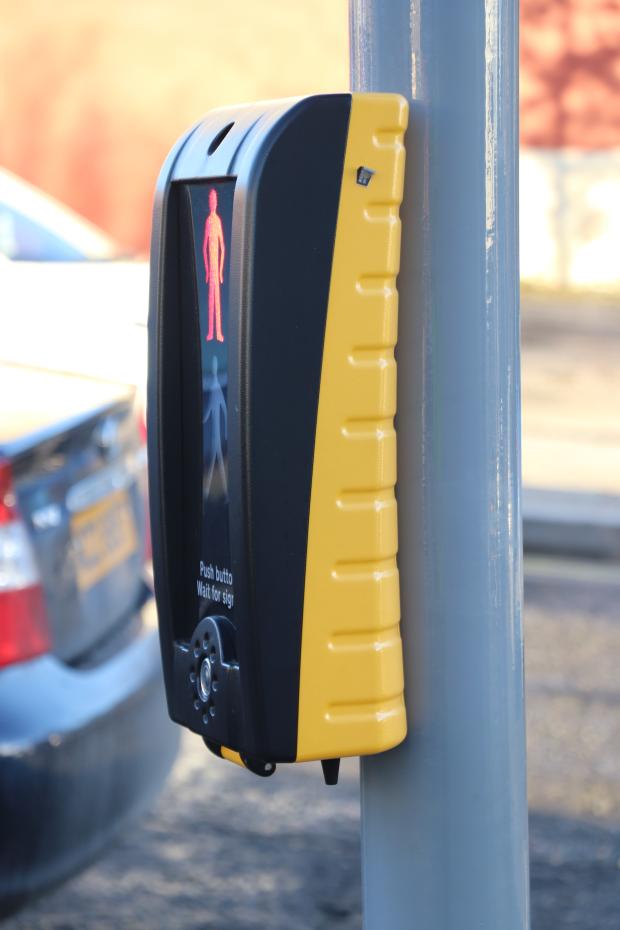Pedestrian facilities for blind and partially-sighted people
Find out about tactile paving and devices at crossings to help if you are blind or partially-sighted.
Tactile paving
The top surface of tactile paving is shaped to let you feel it underfoot. It is mostly used to show where a road crossing is but can also be used at the top and bottom of steps or to show where a cycle route runs alongside a footway.
Different types of surface profiles are used in different situations.
Crossings
Tactile paving is used to let you know where a dedicated crossing point is.
At all new dedicated crossing points, the footway and the road will be at the same level to help wheelchair users.
If you are blind or partially-sighted, the lack of a kerb edge makes it difficult for you to know where the footway ends and the road begins. Tactile paving is used to help warn you that you may be about to step onto the road.
The tactile paving used at dedicated crossing points has rows of raised ball-like blisters which are set in line to help show you the right direction to cross the road.
It is also coloured to stand out from the surrounding footway surface and the colour used will depend on the type of crossing.
Red paving is used at crossings where the traffic has to stop to allow pedestrians to cross, such as:
- zebra crossings
- pelican crossings
- puffin crossings
- toucan crossings
- road junctions with traffic signals
Buff or light brown paving, or any colour other than red that contrasts with the surrounding surface, is used at other dedicated crossing points where there is nothing to control the flow of traffic and make it stop.
These crossings are usually at junctions and may include features such as:
- lowered kerbs
- tactile paving
- central pedestrian refuges
- footway build-outs
- speed reducing features such as road humps
At all crossings there will normally either be two or three rows of tactile paving in the approach to the kerb edge of a crossing point. The width of tactile paving will match the length of the lowered kerb.
There may also be a stem which extends to the back of the footpath. This forms an ‘L’ shape of tactile paving and is provided to help guide you to either the push button controls or the zebra pole of the crossing.
Steps
Tactile paving is used to show the top and bottom of steps. Here it will have rounded, parallel, corduroy-like bars which run the width of the tile. The tiles are laid so that the bars run across the direction of pedestrian travel.
Shared footways and cycleways
Tactile paving is used to show where pedestrians and cyclists share a footpath separated either by a white line or by a raised white line with sloped sides.
This tactile paving, while similar to the corduroy paving used at steps, has flat topped bars instead which run the length of the tile.
The tactile paving is parallel to the direction of travel at the start and finish of the cycle lane section and across the direction of travel at the start and finish of the pedestrian section.
Where the shared route is a large distance, tactile paving should be repeated at intervals so you know you are still on the right side of the route.
Devices at crossings

Two types of device can be at crossings controlled by traffic lights - either audible ‘beeping’ signals or tactile signals, such as rotating cones.
These devices operate when the 'green pedestrian symbol’ or ‘it’s safe to start to cross’ phase of the lights is displayed.
Audible signals make a continuous beeping sound when it is safe to cross. For the safety of pedestrians these are only provided at crossings away from all others or at junctions where the traffic in all directions is stopped at the same time.
Tactile signals or ‘rotating cones’ are found on the underside of the push button control box and rotate when the 'green pedestrian symbol’ appears and it is safe to start to cross.
More information
For queries about any of these measures, contact your local Department for Infrastructure (DfI) Roads office in your council area.